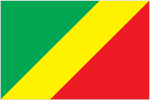More Information about Republic of the Congo
 With its 4,662,446 people, Republic of the Congo is the
124th largest country in the world by
population. It is the 64th largest country in the
world by area with 342,000 square kilometers.
With its 4,662,446 people, Republic of the Congo is the
124th largest country in the world by
population. It is the 64th largest country in the
world by area with 342,000 square kilometers.
Upon independence in 1960, the former French region of Middle Congo became the Republic of the Congo. A quarter century of experimentation with Marxism was abandoned in 1990 and a democratically elected government took office in 1992. A brief civil war in 1997 restored former Marxist President Denis SASSOU-Nguesso, and ushered in a period of ethnic and political unrest. Southern-based rebel groups agreed to a final peace accord in March 2003, but the calm is tenuous and refugees continue to present a humanitarian crisis. The Republic of Congo is one of Africa's largest petroleum producers, but with declining production it will need new offshore oil finds to sustain its oil earnings over the long term.
